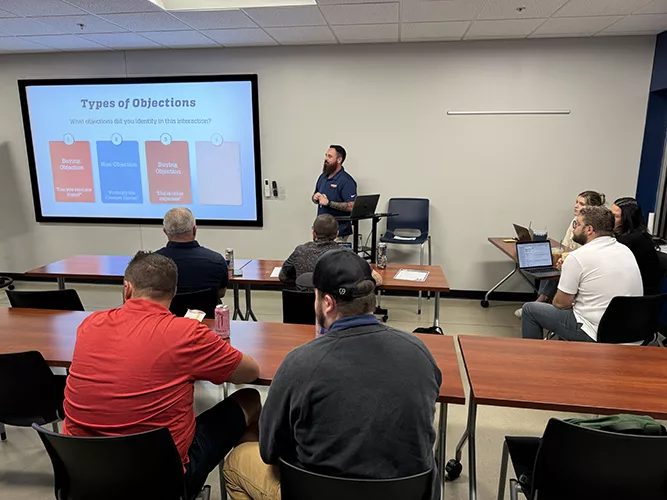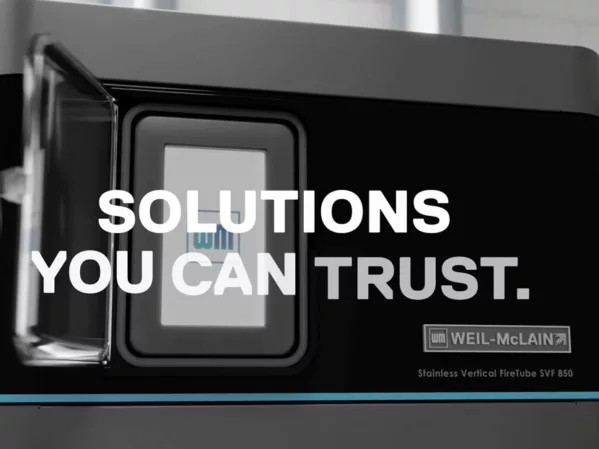In 2011, Chad Peterman joined Peterman Heating, Cooling and Plumbing, Indianapolis, as employee No. 21 when sales were around $4 million. Father Pete Peterman had started the business out of his garage in 1986. Over many of those years, he was mostly content with providing HVAC services.
“Dad was never a plumber,” Chad says, “he was a heating guy.”
Still, enough customers had asked him about plumbing that he eventually added that, too.
Two years after Chad joined, his younger brother Tyler came aboard after graduating from college. And by 2015, their father handed over day-to-day responsibilities to his sons and the next generation started to put their mark on operations with Chad as CEO and president and Tyler as the vice president of installation operations.
From 2016 to 2018, for example, annual revenue at the business doubled to just under $16 million. And from 2018 to 2022, revenue rocketed by 560 percent to just over $88 million. Today, the company, known as Peterman Brothers since 2021, employs 500 employees from 10 locations, four opened in the past two years, in Indiana as well as Ohio and Kentucky and expects to end this year with $100 million in sales.
The company operates out of Greenwood, Indiana from a 23,000-square-foot administrative building and a 54,000-square-foot operations centers that includes extensive warehouse space and training rooms.
How exactly did it get to this size in a relative short amount of time? The brothers certainly have made some acquisitions, and they left behind low-bid commercial work to focus on residential work, plus a membership in Nexstar Network helped nurture the plumbing side of the business. The original HVAC service still accounts for about two-thirds of service calls, but plumbing and the newest venture into the electrical market are growing just the same.

Empowerment
However, you don’t really have to pin down Chad too much for the real reason for this tremendous success.
“I think the true driver of our growth is that we are very intentional around growing and empowering our people,” Chad explains. “At the end of the day, we’re in the business of developing our people to take very good care of our customers. And to do that we have to take very good care of our people. So we’ve really emphasized training and made sure to provide everyone with what they need to be successful.”
Lately, that intention takes the shape of The Peterman Way, which emphasizes a customer-centric approach to delivering service. The all-encompassing training philosophy includes general sessions on sales and installation that you might expect, but also includes “micro-training,” which targets specific skills gaps, and an innovative Direct Field Support program, which provides coaching and guidance to new hires (and seasoned techs) with coaching directly in the field.
We saw a little of everything during our early morning visit last September. A general sales training program was starting at 7 a.m. on that day, but other regularly scheduled Peterman Way classes also cover service; maintenance; installation and technology. But we ended up spending most of our first hour watching Danny Zatarain, learning and development manager, lead one of the micro training programs, this one on overcoming objections.
The class started with everyone reviewing “game day footage,” in this case an actual Zoom call between a tech and a customer who had called in Peterman for some major HVAC work. After the review, everyone broke up into a couple of teams with Zatarain role playing a customer and effectively leading a round robin competition on how to overcome objections, which went something like this:
Zatarain: “You did give six different options. So that is very different than what anybody else did. So let me tell you this. I mean, bottom line is you’re too expensive. So what can you do to bring the price down?”
Tech: “That’s a great question. If I was going to bring the price down, that means I would have to cut corners and that includes quality, reliability, safety and health. What corner should I cut?”
Zatarain: “I don’t want you to cut any corners. I’m just really looking for a discount. So what can you do with that? Something like one of your competitors which was probably about $2,000 less.”
The Next Tech In Line: “OK. Well, we did provide different options so we could look at one other lesser expensive options. That would bring the price down. What do you say then?”
Zatarain: “That’s a really good question. I mean, I think that’s much better, but I’m not trying to lose any services. I’m just looking for a discount.”
The Third Tech In Line: “We did offer you a number of relevant solutions. And you also said you were interested in financing. What if I told you we had different financing options to make that affordable? What would you say to that?”
You get the picture.
“Remember objection handling is not about selling or manipulating people,” Zatarain told the class of about 20 techs. “Objection handling is just another service we provide to the customer. Often times, a lot of what is going on inside the minds of your customers can be overwhelming. We can walk them through all this and help them reach their own conclusions and make the right decisions for themselves.”
While we observed objection handling, Zatarain also covers such topics as connecting; handling conflict; concluding a call; and restoring trust in his other micro training sessions. Additional micro training is in the works for not just techs, but many administrative roles at Peterman Brothers.
“We’re able to see from our data who’s struggling with what,” Chad explains. “Everyone can use an extra hand from time to time. Plus, some topics like financing aren’t always used by every tech every day. It may be just a small repair, for example, where finance questions don’t need to be raised. But if we have an opportunity for larger repairs or installation options, then there’s an opportunity for a trained tech to help customers get what they need at an affordable monthly payment.”

DFS Coach Training
Later that morning, we stopped in to talk to the team responsible for the company’s Dedicated Field Support Program designed to help techs, particularly those new to the field, improve their customer communication and build trust with customers. The DFS program provides real-time coaching and feedback to techs, allowing them to learn from each customer interaction and become more effective communicators.
The key aspects of the DFS program are:
• It is designed to help field professionals implement new training and processes more effectively by providing them with ongoing support and guidance, rather than just relying on a one-time training session.
• The program, which can last for a number of weeks, is customized for each participant, with coaches working closely with them to identify and address specific areas for improvement.
• The coaches focus on providing day-to-day support and training, rather than just holding the field professionals accountable for results.
• The program is intended to be a resource not just for the field professionals, but also for their managers, fostering better collaboration between the two teams.
• The overall goal of the DFS program is to help field professionals deliver a consistently high level of customer service by providing them with the necessary tools and support.
“DFS was really born out of the idea that you can have an amazing training program, but there’s still a percentage of the knowledge that is not retained and that’s not going to be retained until somebody tries it out in the field and they go through failures and successes in order to build their confidence to do so,” Zatarain explains. “Just having a two- or three-day training session and then sending someone out, expecting them to implement a whole new process isn’t the most effective way to do that.”
After talking with Zatarain, we also met Zach Smith, one of the DFS trainers, who described how he offers support for techs directly in the field on service calls.
“The techs call us twice on every service call,” Smith explains. “Once when they’re on their way and we can came up with a game plan for the call knowing what we know about the account from what we can see here back in the office about the customer’s service history.”
After the tech enters the home and diagnoses what needs to be done, the tech will call Smith one more time and “we’ll help them build some options for the call to provide the customer and practice any needed presentation. It’s how we create that consistent Peterman Way customer experience across all our locations we’re in.”
Last but certainly not least, we also sat in on a two-day Leadership Training session that focuses on how the company’s managers are trained to lead “The Peterman Way.”
As the company continues to expand, it needs branch managers and its current roster of employees is looking for opportunities to advance.
“The first day in class covers key principles and practices we’ve built for effective leadership across our teams,” Zatarain explains. “The second day is dedicated to a Peterman facilities tour, where attendees see our operations up close, explore our headquarters, and join Q&A sessions with key team members from departments like marketing, HR, and, of course, Chad himself.”
Born Out of Necessity
To hear Chad talk about it, much of the emphasis on training came from necessity.
“My brother and I came from outside the industry at an early age,” he says. “We had to trust others who knew how to do the trade work. Empowerment of our people became a core belief for us.”
As we mentioned, Tyler came to the company straight from college. After Chad graduated from college, he moved to North Carolina and worked for a couple of years in sales at an adhesive company.
He admits to not thinking too much about joining the family business, but thought more about it as he gained experienced at the manufacturer.
“Dad’s business was much more than just replacing furnaces and water heaters,” Chad explains. “It’s about serving customers and, most importantly, taking care of the people who work here. That meant a lot to me. Once I got into, I really did fall in love with the business.”
After joining the business, Chad enrolled in the MBA program at the University of Indianapolis and realized just how special his father’s business was.
“My classmates were working for large local corporations,” Chad adds. “It seemed like their ability to test out our coursework was rather limited. But I had my hands on the wheel and was able to get a lot out of my MBA simply because I could put our business lessons right to work quickly.”
One leadership trait, Chad says, seems so simple, but so many people get wrong.
“If you want people to follow, then they have to first know that you care,” Chad explains. “I think that’s one of the things I’ve tried to kind of over index is just care and compassion for our people.”
It’s one big reason Chad tries to get around the headquarters, knowing names and saying hi. Even as the company has grown, he knows the small things add up and ultimately creates an environment where once they know the company cares, they’ll run through walls for Peterman Brothers because they want to do their part.
“That’s really what we’ve kind of fostered here at Peterman Brothers,” Chad says. “I knew that I had to treat our technicians like gold and make sure they have a great place to work and they love coming to work. I knew that I had to create that because that was the only way possible that I could actually succeed in this technical business.”
(And by the way, if anyone’s wondering where Tyler is in this feature, he was out and about for most of our morning meeting and only joined us to have this issue’s cover photo taken.)
We shared this story when we first paid a visit to Chad and Tyler three years ago. But it’s too good not to tell it again.
While plenty of family members of PHC businesses can say they grew up in the business, Chad’s got most beat. His mom, Beth, was six months pregnant with Chad when his father, Pete, decided that that was the best time to go into business for himself.
“My dad still tells this story,” Chad says. “You can only imagine how that conversation went over. He started by knowing how many bills he had for that week, so he would know how much money he needed to bring home. But he also started with one goal in mind that my brother and I continue pushing forward to this day: Take care of the customer. It’s interesting that even though we have a lot more people and we can do a lot more jobs and we take care of a lot more customers, the goal is still the same.”





